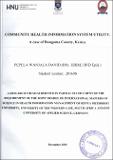Community health information system utility.
Abstract
A wealth of data is available within the healthcare systems more so at community level. However, lack of effective use of information shared during dialoguing at the community level in Bungoma County posed a great challenge despite efforts by government in recognising community care services as critical level 1 service. Health indices have remained on a worsening trend with service utilisations very low. The purpose of the study was to inform service utilisation, promote use of community health information to improve health outcomes. The main objective was to determine the community health information system utility to improve health outcomes in Bungoma County. The specific objectives were to assess the community units level of use of information processes for improved community health services; to identify the technical tools for sharing information during community dialogue and action days; establish community health information system capacities affecting sharing of available information and determine what organisational factors influence sharing and use of community health information. The study was descriptive cross-sectional design. The study employed a combination of stratified clusters proportionate to population size and applied simple random sampling technique with a proportion of 30% of target population as representative sample. The target population was (N =163) with a sample size of nh =54 community units. A structured interview questionnaire both closed and open-ended was administered to Community Health extension workers and 3 in-depth focus group discussions. Data analysis generated univariate frequencies and interpretation using tables and charts. The expected outcome was utility of health information. Results showed that response rate 44 (81.5%), 35 (79.5%) with knowledge on data management and 39 (88.6%) generated monthly summaries with 34(77.3%) with overall utility of community information using white/chalkboards. 27(60.6%) provided feedback and shared information during dialogue days monthly at 41(93.2%) and 17(38.6%) respectively. Information had inadequate involvement in design 14(32%), unavailability of data tools in 39(89%) and less use of appropriate technologies. 26(59.1%) had knowledge on kind of information required, 27(61.4%) analysed this information while, 42(95.5%) used information for evidence based-decision making. Income generating activities supported by partners in 6(13.6%) of the units. Community formal structures was in 32(72.7%) units and shared information in dialogue 54(100%), 36(81.8%) using "Barazas" while, 31(70.5% through health promotion and education. Majority 40 (90.7 %) were empowered through support supervision using standard procedures and checklists. Regression analysis using ANOVAa showed that results were moderately correlated with utility of community information with correlation Coefficientsa 0.017 at 13 0.538b, while Pearson Chi-Square Tests compared with use of information with linear association of 0.910 had a likelihood ratio of Fisher's Exact Test of 0.658 thus, result moderately significant. In conclusion knowledge was above average; information was regularly shared through community dialogues; while design, technical tools and empowerment of communities were weak and inadequate and finally the system was well structured though not resourced and uncoordinated. It was recommended that both National and County governments to emphasize on regular feedback to promote information utility; adequately provide technical capacities and mentorships;

